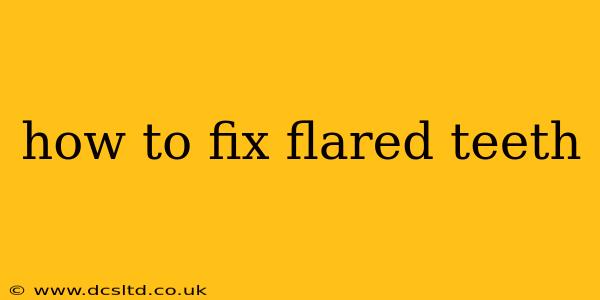Flared teeth, characterized by teeth that stick out prominently from the gum line, can affect both the aesthetics and function of your smile. Fortunately, there are several effective ways to address this dental concern. This guide explores various treatment options, helping you understand your choices and make informed decisions about improving your smile.
What Causes Flared Teeth?
Understanding the root cause of flared teeth is the first step towards finding the right solution. Several factors contribute to this condition, including:
- Genetics: Inherited jaw structure or tooth size can predispose individuals to flared teeth. A small jaw that struggles to accommodate a full set of teeth is a common culprit.
- Thumb Sucking: Prolonged thumb sucking, especially past the age of 5, can significantly influence tooth positioning, leading to flaring.
- Tongue Thrusting: The habit of pushing the tongue against the teeth can exert pressure, causing them to protrude.
- Missing Teeth: The absence of teeth can lead to shifting and flaring of the remaining teeth.
- Early Loss of Baby Teeth: Premature loss of primary teeth can create space issues, impacting the eruption and alignment of permanent teeth.
How Can I Fix Flared Teeth?
The best treatment option for flared teeth depends on several factors, including the severity of the flaring, the patient's age, and overall oral health. Here are the primary methods:
1. Orthodontic Treatment (Braces)
Orthodontic treatment using braces, whether traditional metal braces or clear aligners like Invisalign, is often the most effective method for correcting flared teeth. Braces gently apply pressure to reposition the teeth into their ideal alignment. The duration of treatment varies depending on the individual's case.
2. Invisalign
Invisalign is a popular alternative to traditional braces. It uses a series of clear, removable aligners to gradually shift the teeth. Invisalign is a great option for mild to moderate flaring, offering a more discreet approach to teeth straightening.
3. Palatal Expander
For individuals with a narrow palate, a palatal expander can be used to widen the upper jaw, creating more space for the teeth and reducing flaring. This is often used in younger patients whose jaw bones are still developing.
4. Extraction
In some cases, extracting certain teeth might be necessary to create space for proper alignment and reduce crowding, which can contribute to flaring. This decision is typically made on a case-by-case basis by an orthodontist.
What are the Different Types of Braces?
Traditional Metal Braces: These are the most common type, made from metal brackets and wires. They are effective and relatively inexpensive.
Ceramic Braces: These braces use tooth-colored brackets, making them less visible than metal braces.
Lingual Braces: These braces are placed on the inside surface of the teeth, making them completely invisible. However, they can be more challenging to clean and may cause more discomfort initially.
How Long Does it Take to Fix Flared Teeth?
The treatment duration varies significantly depending on the severity of the flaring and the chosen treatment method. Treatment with braces can typically last anywhere from 12 to 36 months, while Invisalign treatment times can be similar. Palatal expanders often have shorter treatment periods.
Are There Non-Orthodontic Options?
While orthodontic treatment is generally the most effective and long-lasting solution, some minor cosmetic adjustments can be made with veneers or bonding. However, these are only suitable for very mild cases of flaring and don't address the underlying cause.
How Much Does it Cost to Fix Flared Teeth?
The cost of treatment varies greatly depending on the complexity of the case, the chosen treatment method, and the location of the dental practice. It's best to consult with several orthodontists to get a personalized estimate.
Conclusion
Addressing flared teeth requires a professional evaluation. Consulting an orthodontist is crucial for determining the underlying cause and selecting the most appropriate treatment plan tailored to your specific needs. Remember, a healthy and well-aligned smile not only enhances your aesthetics but also contributes to better oral health and function.
